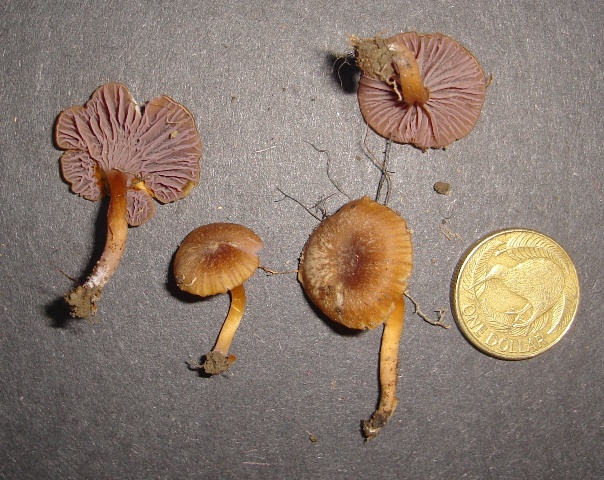This is the second blog and contribution to a fungal checklist for this new mainland island reserve, 3 June 2012. The first contribution is here.
The List:
Gymnopilus junonius [giant flamecap]: This was growing amongst grass on the track that follows the protective fence that prevents pest mammals entering the reserve. Although appearing to be growing on soil this is a wood decay fungus and is probably growing on decaying wood that was buried when the track was formed. This is not a native fungus and will probably disappear from the reserve as the forest regenerates.
Scleroderma verrucosum [warted puffball]: These puffballs were growing on a steep cutting below planted manuka (Leptopsermum scoparium) and gorse (Ulex europeus). It is probably a mycorrhizal partner of the manuka. These are almost mature fruitbodies with the flesh having been converted to a purple black spore mass which will become dry and powdery when fully mature. [Note 16.07.2016: This is more likely to be Scleroderma radicans see the discussion in this later blog.]
Tylopilus formosus [velvet bolete]: This species was in list 1 but that the fruitbody was distorted by growing under a root. This is a much more typical specimen with its purplish-black velvety cap and pinkish pores.
Clavaria corallinorosacea [rose coral]: Identify coral fungi is difficult at the best of times but without a microscope almost impossible. Using Petersen (1988) I got it down two one of two species either Clavaria corallinorosacea or Clavaria phoenicea var. persicina, the first with ellipsoid spores and the latter with globose spores. I have gone with Clavaria corallinorosacea but happy to be corrected.
Cortinarius sp [webcap]: This appears to be similar to the Cortinarius species included in list 1, just much smaller. Note the strong purple colouring in the upper stipe and the dusting of brown spore.
Crinipellis filiformis [leaf horsehair]: Most know the more common Crinipellis procera (tall horsehair) with its long tough stipe, up to 100-120 mm, and growing from twigs. Crinipellis filiformis differs in being less common, shorter, less tough, and growing on leaves rather than twigs.
Geoglossum australe [an earth-tongue]: These are not basidomycetes but ascomycetes so belong with the cup fungi. Michael Kuo (Mushroom.Expert.com) says of Geoglossum: “a nightmare to identify–but if you are a microscope geek, they often reward you with fascinating and funky microscopic features”. What more can I say?
Gliophorus chromolimoneus [chrome waxgills]: There are a couple of yellow waxgills and this one, typical of the genus Gliophorus, has a slime-coated cap and stipe.
Humidicutis pura [white waxgill]: This specimen shows the typical radial splitting of the cap as it ages that is a good character to set Humidicutus apart from the other waxgill genera (see Gliophorus above).
Hygrocybe sp. [black’n’yellow waxgill]: This is close to Hygrocybe (Bertrandia) astatogala which has red-orange colouring in the gills and stem underneath the blackening. It may well be that black’n’yellow waxgill is only a colour variant of Hygrocybe astatogala

Hygrocybe sp. – the fruitbodies blacken with age – compare the old fruitbody on the left with the younger on the right (photo Geoff Ridley)
Laccaria sp. [a deceiver]: This little Laccaria does not match any of the described species for New Zealand. Typically deceivers have thickish and widely spaced gills. They can also have purplish colouration in the gills or more generally – see next species.
Laccaria fraterna [two-pronged deceiver]: Recognised by its cinnamon coloured cap and pinkish to purplish gills. In this species, the basidium produces two spores, hence the two-pronged, rather than the usual four spores.
Mycena ura [crimson helmet]: The red is washed out in this photo and ‘ura‘ revers to the red colour of pohutukawa (Meterosideros excelsa) flowers. These mushrooms were under 10 cm in diameter. The stem bleeds a red sap when cut.
Lycoperdum compactum [wood puffball]: This is the only wood decay puffball and is usually found growing on well-decayed wood. In this case, I could push my finger through the wood. This specimen was immature and when cut in half the flesh was solid and white. As it matures the white flesh will develop into a dry, powdery spore mass (compare with the Scleroderma above).

Lycoperdum compactum showing solid white flesh that has yet to develop into a spore mass (photo Geoff Ridley)
References
Pettersen RH 1988. The clavarioid fungi of New Zealand. Department of Scientific and Industrial Research. DSIR Bulletin 236.


























